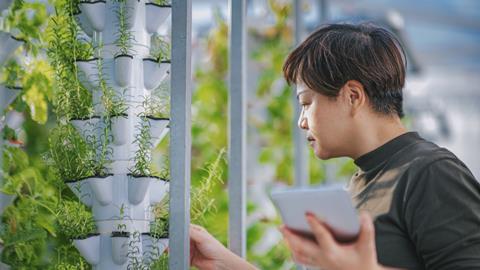Understanding and advancing food safety is critically important to reduce the morbidity and mortality associated with foodborne disease. The WHO estimates that each year, 33 million avoidable deaths are attributable to unsafe food and that one-third of these deaths are in the under-5 age group.
It can be extremely difficult to trace an outbreak of foodborne disease to a common foodstuff. The usual suspects include meat, eggs, fish and shellfish; however, outbreaks of foodborne illness are increasingly associated with leafy greens, chopped salads and herbs; a recent CDC investigation implicated leafy greens in up to 22% of US outbreaks.
Contamination of leafy greens with foodborne pathogens can occur during crop production, processing, or by consumers themselves (e.g. cross-contamination in the kitchen). During processing, bacterial contamination is often found in the water used to wash the produce, as well as on shredders, knives and conveyor belts. During production, sources of foodborne pathogens include improperly sanitised water used for irrigation, the presence of nearby livestock which leads to faecal contamination of water or crops, as well as poorly composted manure soil amendments used too close to harvest time. Worker hygiene can also be an important factor, both during production and during processing. Using pathogen detection data and growth dynamics in predictive modelling can provide insight into the overall risk of foodborne illness to consumers from the food being grown.
Following the impact of the COVID-19 emergency response and with the increasing threat of climate change and water restriction, securing a local food supply is now high on the agenda for both international companies and governments. Some are turning to vertical farming to meet demand. Vertical farms have no standardised design, comprising any combination of sensing technologies, internet-of-things connectivity, robotics, controllable LED light recipes, water recycling, hydroponics and climate control. The smaller footprint of land required makes such vertical farms suitable for industrial or urban centres – bringing production closer to the consumer. The drawback of such facilities is in the energy requirements. The cost of electricity can be partially offset by the integration of renewable sources of energy and a selectivity in the choice of crops – Ideally, crops that grow quickly with reproducibly high quality and that have a high market value. Thus, the focus of many vertical farming facilities is production of leafy greens and herbs.
Benefits of a vertical farm from a food safety perspective include decreased supply chain complexity and shorter distance from production to consumer (with year-round production and reduced time to harvest), so following produce from farm to fork is much simpler and tracing of foodborne illnesses can be improved. There is also a ‘low-to-no risk’ of faecal contamination of crops by ruminants, a higher degree of control over water supply and reduced human handling of produce. However, these systems are still beholden to some of the same hazards as their lower tech counterparts – the microbial load of substrate, biofilms on surfaces, contamination of water used in irrigation, seed contamination, poor sanitation and poor processing and handling protocols.
The 16th century Dutch philosopher Desiderius Erasmus is attributed with the saying ‘Prevention is better than cure’. Vertical farms, by their very nature, enable a strategy of prevention. By the introduction of full robotic control, the human element is minimised – reducing the chance of human transmission of faecal pathogens to crops. The isolation of water sources from farm-runoff and the treatment of irrigation water to a potable standard, as well as the opportunity to control how watering is performed (i.e. watering from below rather than overhead) minimises the chance of a waterborne pathogen reaching the edible portion of the plant. The use of abiotic substrates (including vermiculite, rockwool and phenolic foam flotation) in hydroponics can decrease the microbial load and thus reduce the risk of pathogen influx into the tray environment. The detection of pathogens in the irrigation inflow and outflow water can be monitored through bacterial culture, classical molecular detection via PCR, or by functionalised antibody detection in lateral flow devices (e.g. ‘dipsticks’ and other point-of-need devices).
In the future, with the popularisation of portable third-generation sequencing technologies such as the Oxford Nanopore, the entire microbial metagenome could be sequenced on-site at a vertical farm. The monitoring and modulation of the microbiome caused by the introduction and manipulation of communities in substrate additives, is a growing field of study and testing is well suited to high-throughput vertical farming. Machine learning could also be used in the automatic modelling of risks to the consumer and be based on large datasets collected on site from various sensor technologies. The possibility for the detection of pathogens in situ is also rapidly advancing, with the functionalisation of antibody-coated beads for use in microfluidic devices.
Vertical farming addresses some of the common food safety issues associated with field-grown produce, but there are still unanswered questions for the future of this emerging technology.








No comments yet